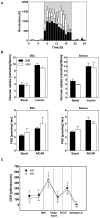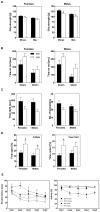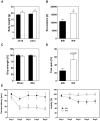An interval of the obesity QTL Nob3.38 within a QTL hotspot on chromosome 1 modulates behavioral phenotypes
- PMID: 23308133
- PMCID: PMC3537729
- DOI: 10.1371/journal.pone.0053025
An interval of the obesity QTL Nob3.38 within a QTL hotspot on chromosome 1 modulates behavioral phenotypes
Abstract
A region on mouse distal chromosome 1 (Chr. 1) that is highly enriched in quantitative trait loci (QTLs) controlling neural and behavioral phenotypes overlaps with the peak region of a major obesity QTL (Nob3.38), which we identified in an intercross of New Zealand Obese (NZO) mice with C57BL/6J (B6). By positional cloning we recently identified a microdeletion within this locus causing the disruption of Ifi202b that protects from adiposity by suppressing expression of 11β-Hsd1. Here we show that the Nob3.38 segment also corresponds with the QTL rich region (Qrr1) on Chr. 1 and associates with increased voluntary running wheel activity, Rota-rod performance, decreased grip strength, and anxiety-related traits. The characterization of a subcongenic line carrying 14.2 Mbp of Nob3.38 with a polymorphic region of 4.4 Mbp indicates that the microdeletion and/or other polymorphisms in its proximity alter body weight, voluntary activity, and exploration. Since 27 out of 32 QTL were identified in crosses with B6, we hypothesized that the microdeletion and or adjacent SNPs are unique for B6 mice and responsible for some of the complex Qrr1-mediated effects. Indeed, a phylogenic study of 28 mouse strains revealed a NZO-like genotype for 22 and a B6-like genotype for NZW/LacJ and 4 other C57BL strains. Thus, we suggest that a Nob3.38 interval (173.0-177.4 Mbp) does not only modify adiposity but also neurobehavioral traits by a haplotype segregating with C57BL strains.
Conflict of interest statement
Figures






References
-
- Reaven GM (2011) Insulin resistance: the link between obesity and cardiovascular disease. Med Clin North Am 95: 875–892. - PubMed
-
- Stunkard A, Faith M, Allison K (2003) Depression and obesity. Biol Psychiatry 54: 330–337. - PubMed
-
- Faith M, Matz P, Jorge M (2002) Obesity-depression associations in the population. J Psychosom Res 53: 935–942. - PubMed
-
- Herva A, Räsänen P, Miettunen J, Timonen M, Läksy K, et al. (2006) Co-occurrence of metabolic syndrome with depression and anxiety in young adults: the Northern Finland 1966 Birth Cohort Study. Psychosom Med 68: 213–216. - PubMed
Publication types
MeSH terms
Substances
LinkOut - more resources
Full Text Sources
Other Literature Sources
Medical
Molecular Biology Databases
Miscellaneous

